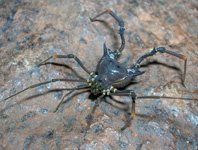Abstract
The geographic range of the Neotropical harvestman Discocyrtus testudineus (Holmberg, 1876) (Gonyleptidae) is addressed by determining the species’ bioclimatic profile and modeling its potential distribution. Analysis was performed on a record set of 71 localities, including literature records and 34 new localities reported here. The bioclimatic profile was characterized through extreme, median and dispersion features of the values of 19 bioclimatic variables across the record set. Predictive models were built with the presence-only methods MAXENT and, secondarily, BIOCLIM. Discocyrtus testudineus is a typical Mesopotamian harvestman, spreading across a wide region along the middle and lower Paraná River in subtropical / temperate Argentina, and extending, more or less continuously, up to the central province of Córdoba. Apparently diverging records (Paso de los Libres, on the Uruguay River, and Quilmes, on the southern coast of Rio de la Plata) proved to be predictable, even if suppressed from the dataset. Comparisons of cumulative frequencies curves and dispersion features (box-plots) were made with Discocyrtus dilatatus Sørensen, 1884 and Gryne orensis (Sørensen, 1884), other Mesopotamian species for which bioclimatic data are available. The relative importance of the bioclimatic variables used for modeling was also estimated.

